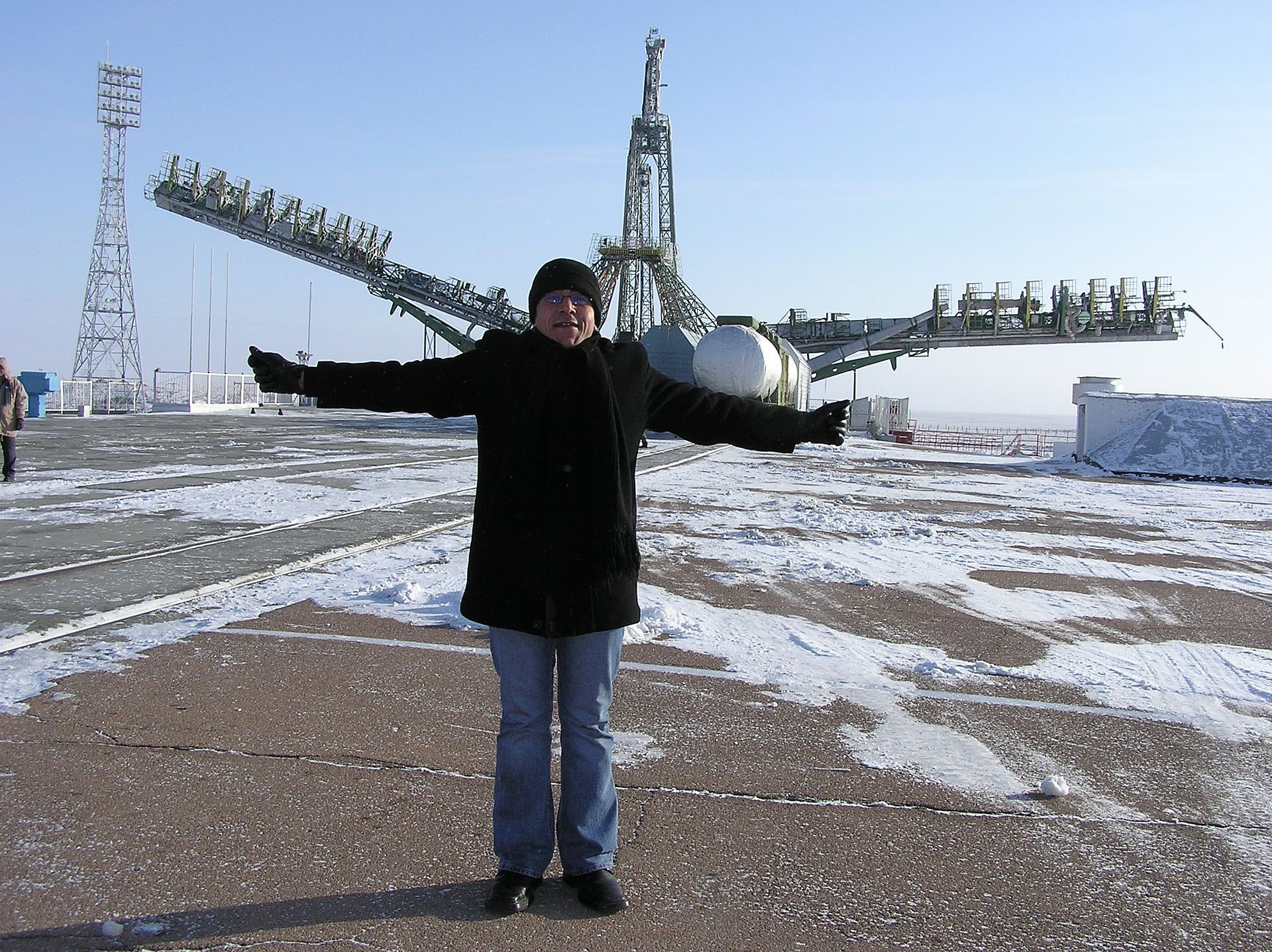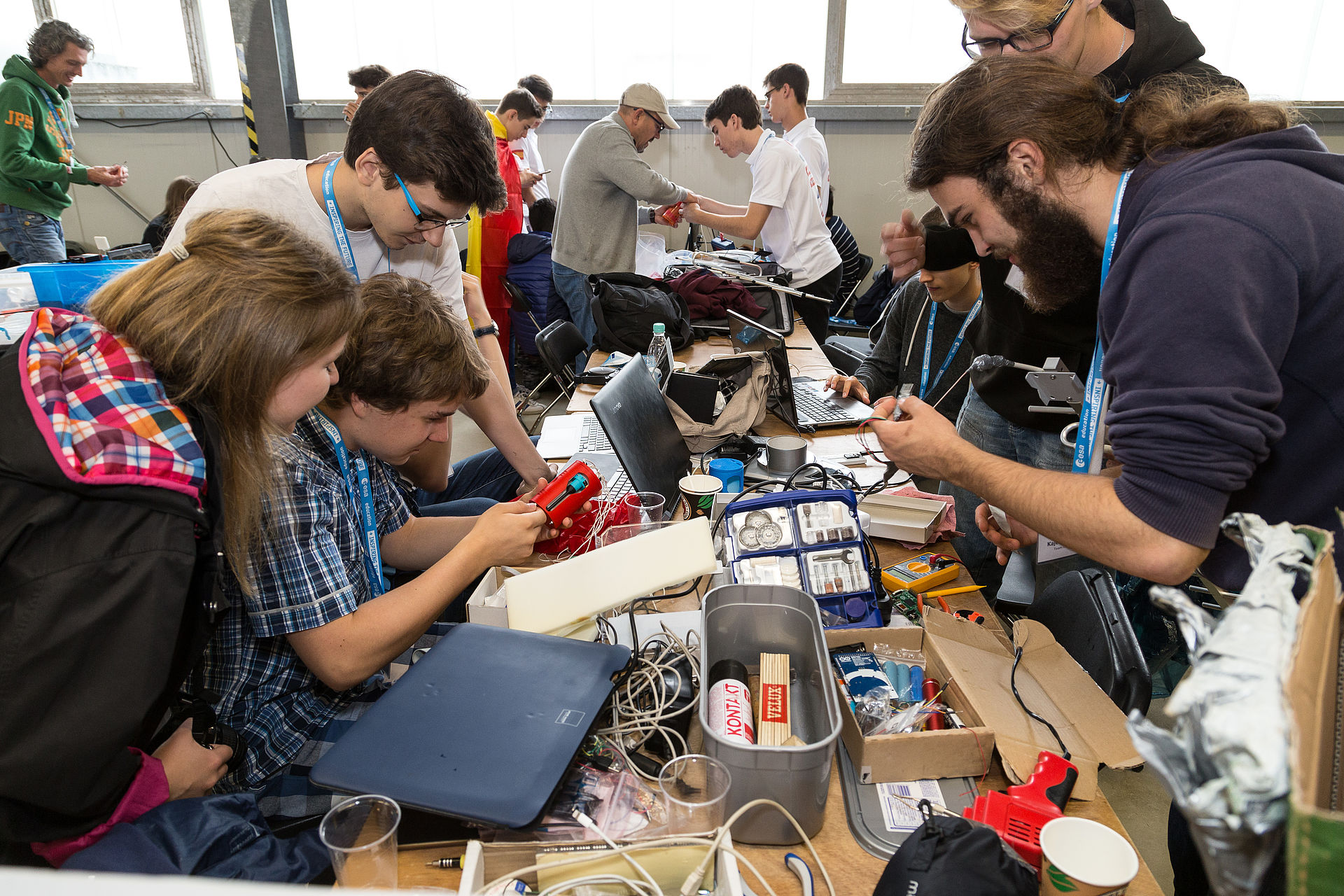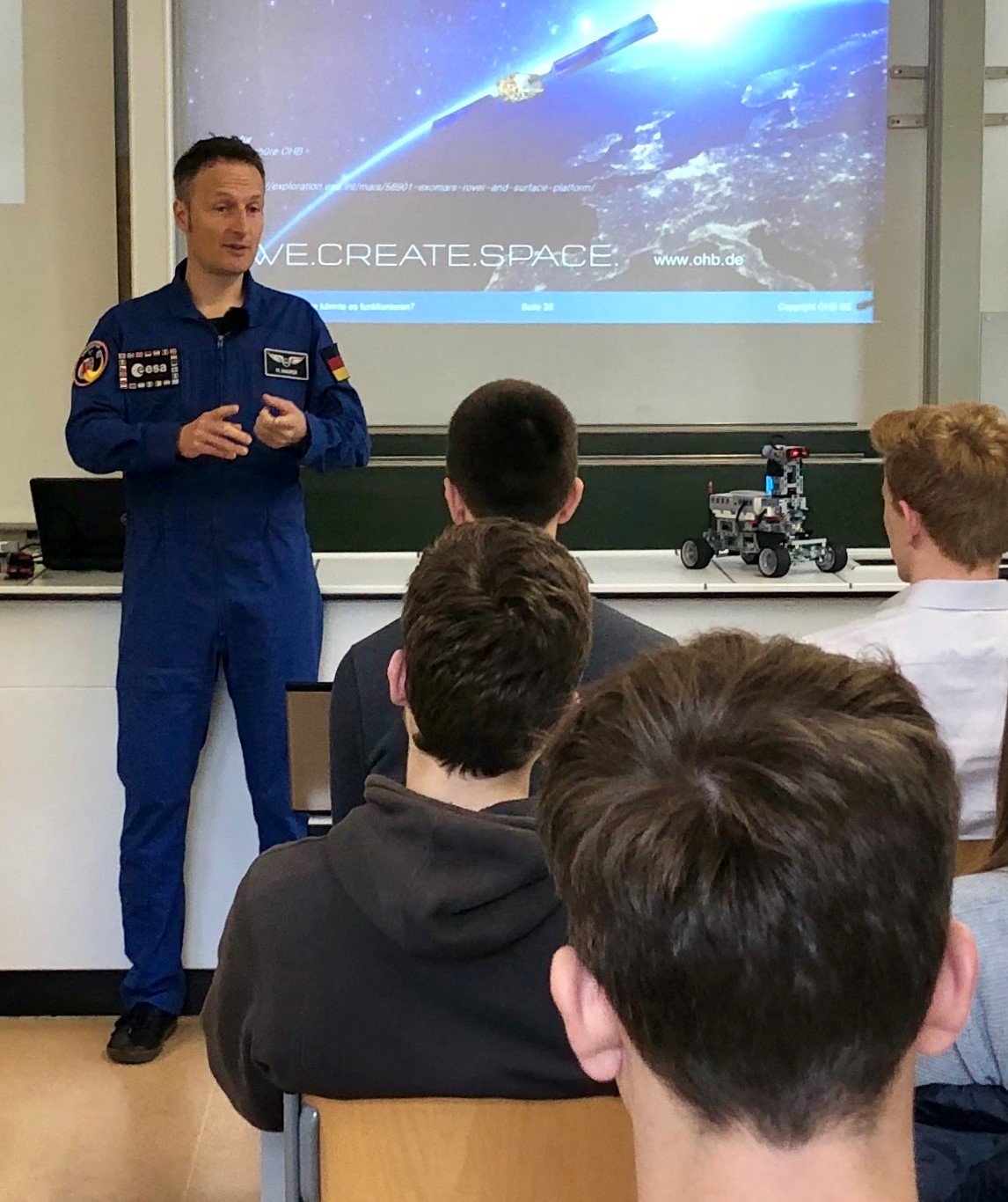When Neil Armstrong became the first man to set foot on the Moon July 20, 1969, Thomas Reiter was 11 years old and watched the event glued to the television screen. A good 26 years later, on September 3, 1995, Reiter is an astronaut himself and on his way to the Russian space station Mir. Part of the mission is a spacewalk - the first to be undertaken by a German astronaut. 2006 a mission to the ISS followed. Reiter spent a total of 350 days in space, making him the European with the second longest stay in space after Alexander Gerst. After his active career as an astronaut, Reiter joined the Executive Board of the German Aerospace Center (DLR) in 2007, where he was responsible for space research and development. From 2011 to 2015, he was Director of Human Spaceflight and Operations at the European Space Agency (ESA). Today, Thomas Reiter is a consultant to ESA Director General Jan Wörner and coordinator for international space agencies.
Let your thoughts drift back to July 20, 1969. Do you remember where you were and how you watched the lunar landing?
Thomas Reiter: Indeed, I do. I was eleven years old at the time. It was an event you never forget. It was early in the morning and my father had woken me. We had been invited to the neighbors, who already had a color TV! The transmission was in black and white of course, but the documentaries before that were shown in color, I still remember it very well. We all sat in front of the TV together and watched Neil Armstrong take his first steps. And, to be quite honest, there wasn’t really much else to see. Still, it was an incredible moment.
Springen Sie bitte mal gedanklich zum 20. Juli 1969. Wissen Sie noch, wo Sie waren und wie Sie die Mondlandung gesehen haben?
Thomas Reiter: Aber natürlich. Ich war damals elf Jahre alt. Das war ein Ereignis, das man nicht vergisst. Es war frühmorgens, mein Vater hatte mich geweckt. Wir waren bei Nachbarn eingeladen, die hatten schon einen Farbfernseher! Die Übertragung war natürlich schwarz-weiß, aber die Dokumentationen davor wurden in Farbe gezeigt, daran erinnere ich mich noch genau. Wir saßen dann alle zusammen vor dem Fernseher und haben die ersten Schritte von Neil Armstrong verfolgt. Wobei man sagen muss, dass nicht wirklich viel zu erkennen war. Dennoch: Es war ein unglaublicher Moment!
What went through your mind as you were watching the TV? Can you still remember?
Reiter: Yes, I can. I wondered what it must feel like to stand on the surface of another celestial body. And this enthusiasm has never faded to this very day. This idea still arouses in me the same enthusiasm today as it did back then.
A human landing on the Moon is an entirely different challenge. Humankind held its collective breath on that day.
This is interesting because alongside Alexander Gerst you are the German who has spent the most time in space. Still, it must be quite different to actually land on another celestial body ...
Reiter: ... definitely!
Why?
Reiter: From an altitude of 400 kilometers you can see the curvature of the Earth, but you don’t see the planet as a whole in space. That’s one of the differences. You also know that in an emergency you can get back to the surface of the Earth from the ISS within three and a half hours. And finally, it is a different technical challenge to land on a celestial body. Apollo 11 bounced over a crater with the last drop of fuel it had before actually landing.
So, you’re saying that the flight on board the ISS was not exciting enough for you.
Reiter: (laughs) I’m deeply grateful to have had this opportunity. But landing on the Moon as a human being is simply an entirely different challenge. Humankind held its collective breath on that day. The whole world sitting on the edge of their seats is something I don’t think we have seen in this form ever again.
The last humans landed on the Moon in 1972 and no one has been there since. How did the view of the Earth from the Moon change humanity?
Reiter: The image of the Earth rising over the lunar horizon was transmitted back to the Earth during the Apollo 8 mission at Christmas 1968 and has massively influenced people’s sense of what the Earth really is. It shows that the Earth is only a small, vulnerable dot in the infinite blackness of space. You also have this feeling to some extent when you view the Earth from the space station, but not in the same way. This impression is certainly amplified many times over the further you move away from the Earth. The awareness of our environment, the sense of what our planet really is, was completely changed by this image.
The view of the Earth from space makes us realize that we can only solve the problems facing the world by working together but never if everyone only looks out for their own interests. This is one of the core insights of space flight.
Today, consciousness of the Earth’s vulnerability to climate change, the destruction of the environment and other problems is far greater than it was 50 years ago. Wouldn’t it be important for this reason alone to enable as many people as possible to expand their consciousness in this way?
Reiter: You’re absolutely right about that. I also think that all my fellow astronauts would agree. Alexander Gerst has also said this on various occasions. It is only the view of the Earth from space that makes us realize that we can only solve the problems facing the world by working together but never if everyone only looks out for their own interests. This is one of the core insights of space flight. And what’s more, it is only when people acknowledge this at an emotional level that it has any effect. Images of probes alone are not capable of generating this change of consciousness.
This all sounds like you think that it’s time to send people to the Moon again.
Reiter: Yes, I think it would make a lot of sense...
... probably also because there is still so much to discover on the Moon.
Reiter: Of course. To answer this question properly, let’s take a step back: what expectations were there in the early seventies? It was assumed that things would continue as they had started. Humans had been on the Moon for a few days at a time, and the next step was to build a lunar station. However, these plans didn’t eventuate. Why not? Because in those days, the Cold War was mainly about demonstrating technological leadership and space capabilities.
But today things are different ...
Reiter: ... of course. A lunar mission is highly interesting from a scientific point of view. The Moon would tell planetary researchers a great deal about the origins of the solar system and particularly about our Earth. The consensus opinion of researchers today is that the Moon originated from a gigantic impact by a meteorite on the primordial Earth four and a half billion years ago. This means that the conditions prevailing on Earth at that time have been frozen in time on the Moon, so to speak. That is why there is so much to learn and find out. That’s the scientific side.
What other aspects are there?
Reiter: Economic ones. There is evidence that significant resources lie slumbering on the Moon. Water is held in the polar regions. Water is an important resource for a longer stay on the Moon as you can drink it, convert it into hydrogen and thus energy, electrolyze it and produce oxygen for breathing. This is important because it would mean that all these resources would not have to be carried to the Moon from the Earth. There are also indications of deposits of raw materials such as rare earths, but it remains to be seen whether it would be worth mining them.
The Chinese recently caused a sensation when they landed a probe on the dark side of the Moon. Why was this so significant?
Reiter: The side of the Moon facing away from the Earth is an excellent observation point for radio and optical astronomy. Above all, it is important for planetary defense.
What does this mean?
Reiter: It is crucial to be able to detect at an early stage whether an asteroid is on a collision course with the Earth in order to deflect it. This is important for the security of the planet. Moreover, the Moon is also a wonderful springboard for further journeys into space, because it has only one sixth of the Earth’s gravitational pull.
You have given three good reasons to return to the Moon. Which one of them is the most important?
Reiter: Not all three can be fulfilled at the same pace. Given the current possibilities for transportation that we have, it is hardly conceivable for resources to be carried from the Moon to the Earth. So, we would probably use the resources locally. Take water for example: if you could find water on the Moon and use it for self-sufficiency, you could stay on the lunar surface for a longer period of time. Consequently, our first priority should be to fly to the polar regions in order to perform these local activities. However, a number of technological steps are still required before we can start producing water for self-sufficiency purposes. We must first prove that this is technically possible before we start transporting humans to the Moon in the second half of the next decade.
When you say people in the second half of the next decade, are you talking about Europeans?
Reiter: This depends on the role that we are willing to play in these activities. With the service module for Orion and possible elements for the Lunar Orbital Platform, we at least have the possibility of gaining a seat at the table, this being a prerequisite for an astronaut from Europe to be able to get to the Moon in the future. The purpose of the Lunar Orbital Platform is to land people on the surface of the Moon. This shows that the lunar project is now more long-term and sustainable in nature than it was at the beginning of the 1970s. If we can get involved here, I think it is very likely that a European will stand on the Moon some day. That would be my wish and I believe that it will be possible in the second half of the decade.
Let’s go one step further: how realistic and, above all, sensible is it to travel to Mars?
Reiter: As things currently stand, it is not yet technically possible. We still have to complete some technical groundwork before we can do this.
What aspects require further work?
Reiter: Protection from radiation, for example. There’s no protective magnetic field on the journey to Mars. Then there is the question of supplies. With the propulsion systems available today, the journey would take two years and all the provisions needed would have to be carried on board. So, before you consider such a scenario, you first have to test it with shorter distances. Accordingly, it is logical not to embark on such an adventure until the technologies required have been developed. When you are ready, you can then take the leap from the Moon.
But Elon Musk says he wants to settle on Mars in 2025 ...
Reiter: ... it’s great for Elon Musk to be able to attract attention to himself with such a vision. Yet, I doubt whether the ability to build an admittedly great launcher is enough on its own to get to Mars and back again. We’re simply not far enough down the road to make this happen by 2025. Visionaries are important to drive us forward, but what they say must also be technically feasible. They don’t have any magic formula. It is not possible to defy the laws of physics.
OHB founder Manfred Fuchs was a visionary of a very different kind. He was advocating a German lunar mission many years ago. In retrospect, how would you rate OHB’s lunar activities?
Reiter: Back when I was responsible for space research and development at DLR, we tried to execute a national lunar mission. This mission was driven not least of all by the ideas that Manfred Fuchs had developed. It was important for such a mission to be endorsed by research institutions and agencies and also to be actively supported by industry. And this was the case with OHB and Manfred Fuchs. This mission was only a hair’s breadth away from reaching fruition.
We can see the Moon every evening and it is the subject of legends and great stories. Above all, however, it is within our reach.
When was this?
Reiter: In 2008, 2009. But unfortunately it didn’t work out for various reasons. The project was then taken to a European level. The Lunar Lander was tabled at the Conference of Ministers in 2012 but ultimately failed for financial reasons. I greatly regretted that decision.
Back to you again: Imagine you are at the beginning of your career, so you could start from scratch again. Would the possibility of landing on the Moon be something that would motivate you?
Reiter: Yes, absolutely. I believe that this has something to do with the fact that we humans are genetically predisposed to always exploring the unknown. This disposition is more pronounced in some people than in others. Yet, the basic tendency to discover new things has always been a driving force for humanity. We want to overcome borders. We can see the Moon every evening and it is the subject of legends and great stories. Above all, however, it is within our reach. I have no doubt that people will return to the Moon one day. And to return to your question: of course I would attempt to land humans on the lunar surface again. I find it fascinating to get to places that technology rather than evolution can take us. I still get goose bumps when I imagine it, just like when I was eleven and sitting in front of our neighbors’ TV set to watch Neil Armstrong take his first step on the surface of the Moon.












